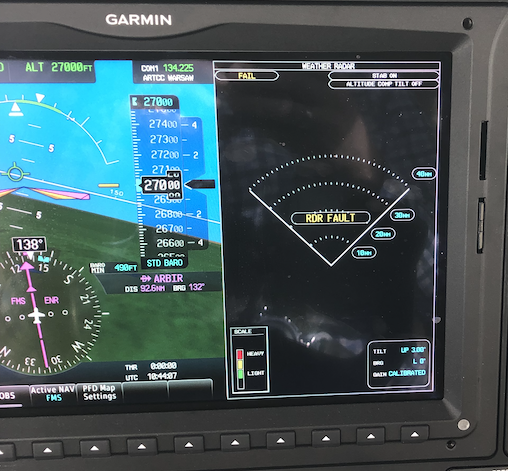@pilot_dar has I believe specific expertise in this area and has written some great detailed posts.
The info I got years ago is that this type of mod has obvious aerodynamic implications and flight testing is needed, including spin resistance. Reportedly Socata had to do all that when they changed the wingtips for the GT change, and that is, one would think, only a small change.
What is the smallest wx radar which actually works? The antenna diameter directly affects resolution, and everything else 
I’ve definitely seen C210s with wing-mounted radomes, so there must be some STC for that. Also, IIRC, Dick Collins used to have one in his C210.
172driver wrote:
I’ve definitely seen C210s with wing-mounted radomes, so there must be some STC for that. Also, IIRC, Dick Collins used to have one in his C210.
It was a factory option. They even had the option of one embedded on the rh leading edge!
Then there were STC’s to install different systems on the existing OEM-approved structural and aerodynamic provisions.

However, adapting and approving this for a tb20 is a major undertaking. Do not go down that path unless on a fixed-price guaranteed-delivery contract.
AlexTB20 wrote:
Is there any option to install a small weather radar antenna on/under the wing of a small single engine aircraft?
Nothing feasible according to my research. Theoretically, wouldn’t even a portable wx radar be possible, accelerometers could be used to stabilize it etc…?
There are interesting YouTube videos of people building DIY radars. Obviously something you rely your life on would need to be very good and reliable and there’s probably too many hurdles.
AlexTB20 wrote:
Would such a small radar increase awareness to a point where it would make sense?
In my opinion yes. I don’t think flying in IMC for extended time periods is safe without airborne wx radar.
Antonio wrote:
Have you also considered a stormscope? This will not give you a warning of precipitation but will definitely indicate real-time convective activity.
What about convective activity without lightning? Even a small build up / embd TCU can cause loss of control.
Ibra wrote:
Ground stations will tend to have reliable data than own airborne radar, the latter may have too much of false returns?
I use multiple ground based radar returns and compare to CB/TSRA at my location. At first I thought the “pop up/growing” rate of CBs was very high (you know the stories about how fast they grow, which confirmed my bias), however now I discover more and more that the reason for these sudden appearances of large cells is topographical. Mountains obstruct the ground based radar until the precipitation is “in sight” by the radar, and then it suddenly appears. I don’t know if how DL weather works precisely, but it has been repeated again and again to not use it for tactical weather avoiding, only as an overview to plan a route, fly a different one or avoid an area by a large margin.
I don’t think there is really any substitute for airborne weather radar. Not even a combination of datalink and stormscope. This may be due to the on board wx radars I am used too which work very well (modern airline stuff)! Someone using a small/old radar might prefer datalink weather info?!
Ibra wrote:
In the other hand they are not scanning straight ahead of you, so you probably need both satellite & airborne weather
Agree!
Peter wrote:
What is the smallest wx radar which actually works? The antenna diameter directly affects resolution, and everything else
I recently discovered a wx radar in a Mooney. It is integrated into the leading edge of the wing, thus quite small in diameter. According to a quick read of mooney forums it doesn’t work well and most owners rip it out. Too small a dish and too old.
Snoopy wrote:
I recently discovered a wx radar in a Mooney. It is integrated into the leading edge of the wing, thus quite small in diameter. According to a quick read of mooney forums it doesn’t work well and most owners rip it out. Too small a dish and too old.
Modern radars are better but you can’t beat the physics. Detection range is based on power density and a small radar antenna means a wide beam angle, so what power is broadcast is spread over a wider beam. Hence effectiveness (range) decreases.
A leading edge arrangement would not have enough vertical resolution but would have plenty of horizontal resolution.
I wonder if anyone has thought about synthetic aperture?
Snoopy wrote:
There are interesting YouTube videos of people building DIY radars. Obviously something you rely your life on would need to be very good and reliable and there’s probably too many hurdles.
With current Garmin offer, DIY may not be such a bad idea. My typical weather avoidance:

I’ll be getting third GWX70 soon. Mechanic also told me of a Honda Jet getting four.
Peter wrote:
plenty of horizontal resolution.
Old airline captain with expensive concert tickets on a delayed flight home goes to manual tilt: „look buddy, we‘re way over the – BOOOM – ok request left heading…“. 
aart wrote:
Or even make a matrix: 2 seaters, >2 seaters, anti-ice, non anti-ice.
Hm. And it appears the only SEP with a AWR is PA-46, others got no radar.